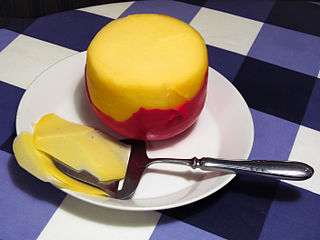
Edam is a semi-hard cheese that originated in the Netherlands, and is named after the town of Edam in the province of North Holland. Edam is traditionally sold in flat ended spheres with a pale yellow interior and a coat, or rind, of red paraffin wax. Edam ages and travels well, and does not spoil; it only hardens. These qualities made it the world's most popular cheese between the 14th and 18th centuries, both at sea and in remote colonies.

Curd is obtained by coagulating milk in a sequential process called curdling. It can be a final dairy product or the first stage in cheesemaking. The coagulation can be caused by adding rennet or any edible acidic substance such as lemon juice or vinegar, and then allowing it to coagulate. The increased acidity causes the milk proteins (casein) to tangle into solid masses, or curds. Milk that has been left to sour will also naturally produce curds, and sour milk cheeses are produced this way. Producing cheese curds is one of the first steps in cheesemaking; the curds are pressed and drained to varying amounts for different styles of cheese and different secondary agents are introduced before the desired aging finishes the cheese. The remaining liquid, which contains only whey proteins, is the whey. In cow's milk, 90 percent of the proteins are caseins.
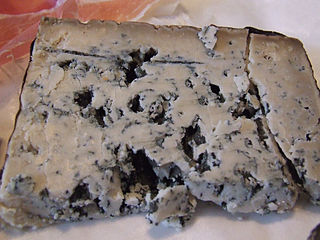
Cabrales is a blue cheese made in the artisan tradition by rural dairy farmers in Asturias, Spain. This cheese can be made from pure, unpasteurized cow’s milk or blended in the traditional manner with goat and/or sheep milk, which lends the cheese a stronger, spicier flavor.

Paneer or Indian cottage cheese is a fresh cheese common in the Indian subcontinent. It is a non-aged, non-melting soft cheese made by curdling milk with a fruit- or vegetable-derived acid, such as lemon juice. Its acid-set form before pressing is called chhena.
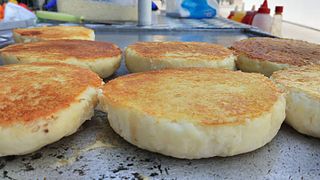
Arepa is a type of food made of ground maize dough, originating from the northern region of South America in pre-Colombian times, and is notable primarily in the cuisines of Colombia and Venezuela, but also present in the cuisines of Bolivia and other countries.

Cachapa or Arepa de Chócolo is a traditional dish made from maize flour from the Venezuelan and Colombian cuisine. Like arepas, they are popular at roadside stands. They can be made like pancakes of fresh corn dough, or wrapped in dry corn leaves and boiled. The most common varieties are made with fresh ground corn mixed into a thick batter and cooked on a budare, like pancakes; the cachapa is slightly thicker and lumpier because of the pieces from corn kernels.

Salvadoran cuisine is a style of cooking derived from the nation of El Salvador. The traditional foods consist of a mix of Native American cuisine from the indigenous groups Lenca, Pipil, Xinca, Poqomam, Maya Chʼortiʼ, Alaguilac, Mixe, Mangue, and Cacaopera; with later influences from Spanish cuisine after the Conquest of El Salvador. Many of the dishes are made with maize (corn). There is also heavy use of pork and seafood.

Queso blanco, literally white cheese in Spanish, can refer to many different kind of cheeses whose only common trait is their white color. The specific cheese referred to depends on the region.
Venezuelan cuisine is influenced by its European, West African, and Native American traditions. Venezuelan cuisine varies greatly from one region to another. Food staples include corn, rice, plantains, yams, beans and several meats. Potatoes, tomatoes, onions, eggplants, squashes, spinach and zucchini are also common sides in the Venezuelan diet. Ají dulce and papelón are found in most recipes. Worcestershire sauce is also used a frequently in stews. Venezuela is also characterized for having large variety of white cheese, usually name by geographical region.
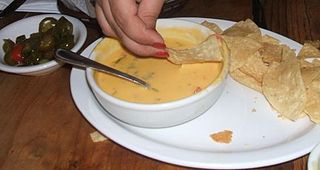
Chile con queso, sometimes called simply queso, is an appetizer or side dish of melted cheese, and chili peppers, typically served in Tex-Mex restaurants as a dip for tortilla chips.
Canarian cuisine refers to the typical dishes and ingredients in the cuisine of the Canary Islands, and it constitutes an important element in the culture of its inhabitants. Its main features are its freshness, variety, simplicity, and the richness of its ingredients, the mix of seafood and meat dishes, its cultural influences and the low knowledge of it by the rest of the world. Canarian cuisine is influenced by other cultures, specially the aboriginal inhabitants of the islands (Guanches) and Latin American cuisine. Some African influences still prevail as well.

Colombian cuisine is a compound of the culinary traditions of the six main regions within the country. Colombian cuisine varies regionally and is particularly influenced by Indigenous Colombian, Spanish, and African cuisines, with slight Arab influence in some regions. Furthermore, being one of the most biodiverse countries in the world, Colombia has one of the widest variety of available ingredients depending on the region.

Cheese is a dairy product, derived from milk and produced in wide ranges of flavors, textures and forms by coagulation of the milk protein casein. It comprises proteins and fat from milk, usually the milk of cows, buffalo, goats, or sheep. During production, the milk is usually acidified and the enzymes of rennet are added to cause the milk proteins (casein) to coagulate. The solids (curd) are separated from the liquid (whey) and pressed into final form. Some cheeses have aromatic molds on the rind, the outer layer, or throughout. Most cheeses melt at cooking temperature.

Queso panela is a white, fresh and smooth Mexican cheese of pasteurized cow's milk. It is not the same as queso canasta or queso de la canasta. It is served most often as part of appetizer dishes such as nopal salads or quesadillas. It is derived from the Greek word for basket cheese. The cheese also has similarities to the Indian cheese paneer.
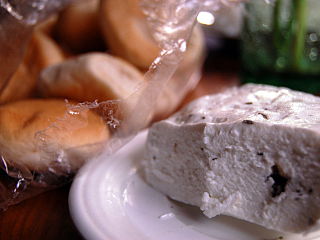
Kesong puti is a Filipino soft, unaged, white cheese made from unskimmed carabao milk and salt curdled with vinegar, citrus juices, or sometimes rennet. It can also be made with goat or cow milk. It has a mild salty and tart flavor. When an acidifying agent is used, it resembles queso blanco or paneer. When rennet is used, it resembles buffalo mozzarella. Moisture content can also vary, ranging from almost gelatinous to pressed and firm. It can be eaten as is, paired with bread, or used in various dishes in Filipino cuisine. It is usually sold wrapped in banana leaves.
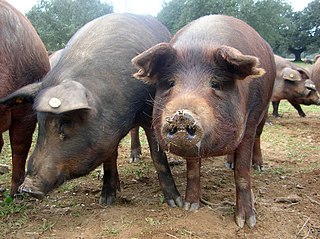
Extremadura, Spain is known for its different ways of preparing the Iberian pork and mutton. The main characteristics of the traditional Extremaduran cuisine were its simplicity, its lack of clutter and its low cost. It is also a cuisine reflecting a generous spirit, for many of its preparations used to be cooked in large pots to share with visitors, friends, and neighbors. The resulting dishes are eaten with local bread.

Cheeses in Mexico have a history that begins with the Spanish conquest, as dairy products were unknown in pre-Columbian Mesoamerica. The Spanish brought dairy animals, such as cattle, sheep, and goats, as well as cheesemaking techniques. Over the colonial period, cheesemaking was modified to suit the mixed European and indigenous tastes of the inhabitants of New Spain, varying by region. This blending and variations have given rise to a number of varieties of Mexican cheeses. These are most popular in the country, although European cheeses are made, as well. Almost all cheese in Mexico is made with cows’ milk, with some made from goats’ milk. More recently, efforts have been made to promote sheep's milk cheeses. Most cheeses are made with raw (unpasteurized) milk. Cheeses are made in the home, on small farms or ranches, and by major dairy product firms. Between 20 and 40 different varieties of cheese are made in Mexico, depending on how one classifies them. Some, such as Oaxaca and panela, are made all over Mexico, but many are regional cheeses known only in certain sections on the country. Some of the least common are in danger of extinction.















